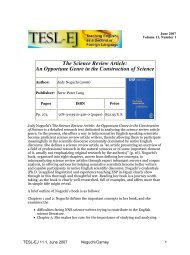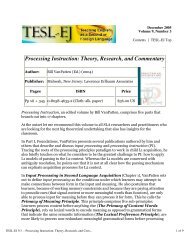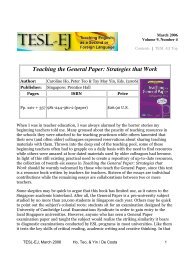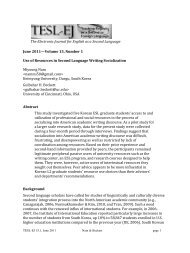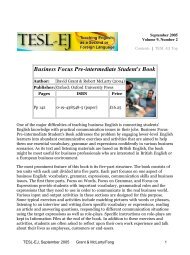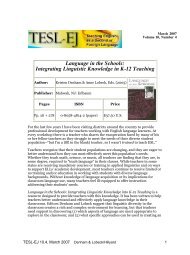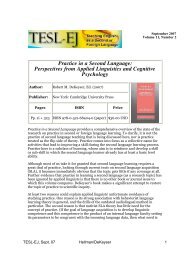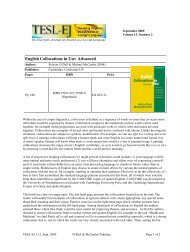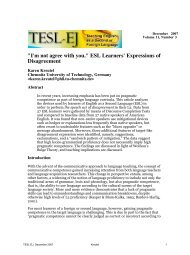Grammar, Meaning and Pragmatics: Sorting Out the Muddle - TESL-EJ
Grammar, Meaning and Pragmatics: Sorting Out the Muddle - TESL-EJ
Grammar, Meaning and Pragmatics: Sorting Out the Muddle - TESL-EJ
You also want an ePaper? Increase the reach of your titles
YUMPU automatically turns print PDFs into web optimized ePapers that Google loves.
<strong>Grammar</strong>, <strong>Meaning</strong> <strong>and</strong> <strong>Pragmatics</strong>: <strong>Sorting</strong> <strong>Out</strong> <strong>the</strong><br />
<strong>Muddle</strong><br />
Michael Swan<br />
<br />
Abstract<br />
The term "pragmatics" is commonly used in two quite different senses. In<br />
linguistic discourse, "pragmatics" refers to <strong>the</strong> strategies (exploitation of<br />
shared knowledge, assumptions about communicative intent, etc.), by<br />
which language users relate <strong>the</strong> dictionary/grammar meaning of<br />
utterances to <strong>the</strong>ir communicative value in context. "<strong>Pragmatics</strong>" in this<br />
sense deals with what is not encoded in language, <strong>and</strong> applies to all<br />
language use. In language teaching, on <strong>the</strong> o<strong>the</strong>r h<strong>and</strong>, "pragmatics"<br />
generally refers to <strong>the</strong> encoding of particular communicative functions,<br />
especially those relevant to interpersonal exchanges, in specific<br />
grammatical <strong>and</strong> lexical elements of a given language. Confusion between<br />
<strong>the</strong> two senses leads to <strong>the</strong> common <strong>and</strong> mistaken claim that all <strong>the</strong><br />
structures of a language encode two levels of meaning, "semantic" <strong>and</strong><br />
"pragmatic," both of which must be learnt for communicative<br />
competence. A fur<strong>the</strong>r common claim, that earlier language teaching<br />
failed to consider pragmatic aspects of language, is equally unfounded.<br />
Two Kinds of <strong>Meaning</strong><br />
September 2007<br />
Volume 11, Number 2<br />
Since <strong>the</strong> early days of <strong>the</strong> Communicative Approach, language teachers have been<br />
told that <strong>the</strong>y have to pay attention to two kinds of meaning: <strong>the</strong> "semantic"<br />
meanings of words <strong>and</strong> structures which can be found in dictionaries <strong>and</strong> grammars,<br />
<strong>and</strong> <strong>the</strong> "pragmatic" values which <strong>the</strong>se linguistic elements take on when <strong>the</strong>y are<br />
used in communication. In an influential paper published in <strong>the</strong> early 1970s (Hymes,<br />
1971), <strong>the</strong> sociolinguist Dell Hymes put forward <strong>the</strong> view that "communicative<br />
competence" involves knowing not only dictionary/grammar meaning, but also <strong>the</strong><br />
rules that determine <strong>the</strong> appropriacy or o<strong>the</strong>rwise of utterances in context. This line<br />
of thought was welcomed for several reasons. Language teachers at <strong>the</strong> time were<br />
dissatisfied, as language teachers usually are, with <strong>the</strong>ir learners' inability to convert<br />
<strong>the</strong>ir knowledge of linguistic forms into successful language use, <strong>and</strong> <strong>the</strong> idea that<br />
<strong>the</strong>y could solve <strong>the</strong> problem by teaching something called "communicative<br />
competence" was an attractive one. The construct offered an engaging alternative to<br />
<strong>the</strong> purely formal type of language competence investigated by Chomskyan<br />
linguistics. It chimed well with <strong>the</strong> concerns of many applied linguists, who were <strong>the</strong>n<br />
Top<br />
<strong>TESL</strong>-<strong>EJ</strong>, Sept. 07 Swan 1
turning <strong>the</strong>ir attention from language on <strong>the</strong> page to language between<br />
people--discourse analysis was <strong>the</strong> new syntax. It added some intellectual kudos to<br />
applied linguistics by forging a link with <strong>the</strong> work of linguistic philosophers such as<br />
Searle <strong>and</strong> Austin, who were also looking, broadly speaking, at what people do with<br />
language. And, quite simply, it fitted in with <strong>the</strong> "spirit of <strong>the</strong> age," which was deeply<br />
concerned with interpersonal dynamics. So Hymes' pronouncement that <strong>the</strong>re are<br />
"rules of use without which <strong>the</strong> rules of grammar would be useless" (1971, p. 278)<br />
became something of a mantra for <strong>the</strong> applied linguists of <strong>the</strong> time.<br />
One of <strong>the</strong> major reasons for questioning <strong>the</strong> adequacy of grammatical<br />
syllabuses lies in <strong>the</strong> fact that even when we have described <strong>the</strong><br />
grammatical (<strong>and</strong> lexical) meaning of a sentence, we have not accounted<br />
for <strong>the</strong> way it is used as an utterance . . . . Since those things that are not<br />
conveyed by <strong>the</strong> grammar are also understood, <strong>the</strong>y too must be governed<br />
by 'rules' which are known to both speaker <strong>and</strong> hearer. People who speak<br />
<strong>the</strong> same language share not so much a grammatical competence as a<br />
communicative competence. Looked at in foreign language teaching<br />
terms, this means that <strong>the</strong> learner has to learn rules of communication<br />
as well as rules of grammar. (Wilkins, 1976, pp. 10-11)<br />
Despite <strong>the</strong> difficulty of clarifying what exactly might be meant by teaching "rules of<br />
use" or "rules of communication" (see Swan, 1985 for discussion), <strong>the</strong> notion that<br />
teachers <strong>and</strong> learners need to concern <strong>the</strong>mselves with two levels of meaning has<br />
remained prominent in pedagogic thought <strong>and</strong> writing. Celce-Murcia <strong>and</strong><br />
Larsen-Freeman, in a widely used course on pedagogic grammar, explain that<br />
"Grammatical structures not only have a morphosyntactic form, <strong>the</strong>y are also used<br />
to express meaning (semantics) in context-appropriate use (pragmatics)" (1999, p.<br />
4). Ellis (2005), discussing <strong>the</strong> need for learners to focus on meaning, similarly<br />
distinguishes two senses of <strong>the</strong> term: semantic <strong>and</strong> pragmatic. Doughty <strong>and</strong><br />
Williams, discussing <strong>the</strong> rationale for <strong>the</strong> task-based teaching of structure, say:<br />
[W]e recognize that <strong>the</strong> term meaning, which is often equated only with<br />
its lexical component, in fact subsumes lexical, semantic <strong>and</strong> pragmatic<br />
meaning. To be more accurate, we note that focus on form includes<br />
forms, meaning <strong>and</strong> function (or use) . . . . We suggest that <strong>the</strong> degree of<br />
effectiveness . . . of focus on form ultimately depends on <strong>the</strong> level of<br />
integration of <strong>the</strong> learner's attention to all three aspects of form,<br />
meaning <strong>and</strong> function in <strong>the</strong> TL. (1998, pp. 244-5)<br />
Problems With <strong>the</strong> "Two Levels of <strong>Meaning</strong>" Notion<br />
The idea that we should be teaching two kinds of meaning is so familiar that we can<br />
easily fail to see how problematic it actually is. Stated in general terms, <strong>the</strong> claim<br />
does indeed seem quite plausible. We know very well that <strong>the</strong> exact significance of an<br />
utterance in communication can be different from <strong>the</strong> apparent meanings of <strong>the</strong><br />
words <strong>and</strong> structures involved. What do you think you're doing? is probably not a<br />
simple enquiry about <strong>the</strong> hearer's mental processes. I thought we might go out for a<br />
drink refers to <strong>the</strong> present, not <strong>the</strong> past. Problems arise, however, when we try to<br />
focus on what exactly is meant, in practice, by saying that in general <strong>the</strong> structures of<br />
a language have both semantic <strong>and</strong> pragmatic meanings, <strong>and</strong> that <strong>the</strong>se can be<br />
taught. Larsen-Freeman, while encouraging teachers to deal with both 'meaning <strong>and</strong><br />
<strong>TESL</strong>-<strong>EJ</strong>, Sept. 07 Swan 2
use' in grammar (2003, pp. 35-42), concedes that for some structures <strong>the</strong> two can be<br />
difficult to tease apart. They certainly can. Plural morphology encodes reference to<br />
more than one entity: is this meaning or use? Whichever it is, where is <strong>the</strong> o<strong>the</strong>r? The<br />
English future perfect refers to anteriority in <strong>the</strong> future; if this is meaning, what is<br />
<strong>the</strong> use of <strong>the</strong> tense? The modal must can express both certainty <strong>and</strong> obligation; but if<br />
one of <strong>the</strong>se is meaning <strong>and</strong> <strong>the</strong> o<strong>the</strong>r use, which is which? Some grammatical<br />
elements, indeed, do not seem to have any kind of meaning. Attributive adjectives<br />
normally precede nouns in English <strong>and</strong> follow <strong>the</strong>m in French, but it is hard to assign<br />
any semantic value to this structural fact. English quantifiers are followed by of<br />
before ano<strong>the</strong>r determiner (some of those people), but not before a bare noun (some<br />
people); again, it seems unrealistic to ask what this "means." And what is <strong>the</strong><br />
"meaning" of gender agreement in French, or of <strong>the</strong> verb-second rule in German?<br />
Why?<br />
If <strong>the</strong> idea that grammatical structures intrinsically have two distinguishable kinds of<br />
meaning, "semantic" <strong>and</strong> "pragmatic," is fundamentally flawed (as I think it is), why<br />
has it persisted for so long? I believe that this has a good deal to do with a<br />
widespread <strong>and</strong> continuing confusion about what exactly is meant by "pragmatic."<br />
Although <strong>the</strong> term "pragmatics," relating loosely to <strong>the</strong> study of "how we do things<br />
with language," is pervasive in discussions of language teaching, it can be very hard<br />
to pin down exactly what people mean by it, or how it relates to syntax, lexis <strong>and</strong><br />
semantics. Essentially, I think that this is because <strong>the</strong> term actually has two very<br />
different kinds of reference that are often tangled up one with <strong>the</strong> o<strong>the</strong>r. Let's call<br />
<strong>the</strong>se "<strong>Pragmatics</strong> A" <strong>and</strong> "<strong>Pragmatics</strong> B."<br />
<strong>Pragmatics</strong> A: What Is Not Encoded<br />
When we encode an utterance, our hearer or reader can use dictionary/grammar<br />
knowledge to decode it to <strong>the</strong> point of establishing its meaning in a kind of<br />
general-purpose sense. But (as we are constantly reminded) <strong>the</strong> dictionary/grammar<br />
meaning of any utterance underdetermines its meaning in context: its "value", or <strong>the</strong><br />
role it plays in <strong>the</strong> ongoing communication. To underst<strong>and</strong> a sentence like Your<br />
driver will be here in half an hour, a hearer needs to feed a good deal of extra<br />
information into <strong>the</strong> utterance: <strong>the</strong> fact that in this instance <strong>the</strong> variable your refers<br />
to <strong>the</strong> hearer him/herself; <strong>the</strong> exact identity of <strong>the</strong> driver in question; <strong>the</strong> location of<br />
here; <strong>and</strong> <strong>the</strong> time frame within which in half an hour has to be calculated. None of<br />
this information is encoded in <strong>the</strong> grammar <strong>and</strong> semantics of <strong>the</strong> sentence itself. The<br />
sentence I still haven't forgiven her for <strong>the</strong> thing about <strong>the</strong> hedgehog <strong>and</strong> <strong>the</strong> music<br />
st<strong>and</strong> depends for its interpretation on shared knowledge that is in no way expressed<br />
by <strong>the</strong> language forms used. Correct interpretations of utterances can indeed take us<br />
a very long way away from <strong>the</strong>ir surface encodings. In specific situations <strong>the</strong><br />
following sentences, for example, might be used to convey <strong>the</strong> messages shown in<br />
brackets (or o<strong>the</strong>r very different ones), <strong>and</strong> be successfully understood as doing so.<br />
Your coat's on <strong>the</strong> floor. ('Pick up your coat.')<br />
Jane's got her exams on Friday. ('I can't come to lunch.')<br />
Let's not have a repetition of last time. ('Don't get drunk <strong>and</strong> start flirting with<br />
Melissa.')<br />
It's Wednesday. ('Put <strong>the</strong> trash out.')<br />
<strong>TESL</strong>-<strong>EJ</strong>, Sept. 07 Swan 3
The linguistic discipline known as <strong>Pragmatics</strong> (what I am here calling "<strong>Pragmatics</strong><br />
A") takes this kind of problem as its principal subject matter. Textbooks on<br />
pragmatics (e.g., Levinson, 1983; Yule, 1996; Horn & Ward, 2004) concern<br />
<strong>the</strong>mselves centrally with <strong>the</strong> principles used by speakers/writers <strong>and</strong><br />
hearers/readers to bridge <strong>the</strong> gap between code meaning <strong>and</strong> context-determined<br />
meaning. Such works typically discuss, among o<strong>the</strong>r things:<br />
<strong>the</strong> way context, shared knowledge, <strong>and</strong> familiarity with conventional<br />
schemata, routines <strong>and</strong> genres all contribute to meaning, <strong>and</strong> are taken into<br />
account in framing <strong>and</strong> interpreting utterances.<br />
<strong>the</strong> "co-operative principle" underlying successful communication, whereby<br />
speakers <strong>and</strong> writers normally avoid saying too much or too little, give true<br />
information, say what is relevant, <strong>and</strong> aim at clarity of expression (<strong>the</strong> maxims<br />
of quantity, quality, relation <strong>and</strong> manner identified by <strong>the</strong> philosopher Grice).<br />
"implicature"--<strong>the</strong> ways in which <strong>the</strong> flouting of <strong>the</strong>se maxims can be<br />
interpreted (e.g., damning with faint praise, showing off, exaggeration for<br />
emphasis, irony, metaphor).<br />
By definition, <strong>Pragmatics</strong> A is concerned primarily with what is not encoded, <strong>and</strong> its<br />
analytical categories are applicable to every act of communication: <strong>the</strong>re is surely no<br />
sentence which has an absolute universal value totally independent of <strong>the</strong> personal<br />
<strong>and</strong> situational context in which it is uttered.<br />
<strong>Pragmatics</strong> B: What Is Encoded<br />
When language teachers talk about "pragmatics," however, <strong>the</strong>y are not generally<br />
thinking about <strong>the</strong> branch of linguistics discussed above, or <strong>the</strong> topics that this is<br />
mainly concerned with. By virtue of being efficient communicators in <strong>the</strong>ir mo<strong>the</strong>r<br />
tongues, students already know how to relate code to context so as to determine <strong>the</strong><br />
communicative intention of a given utterance, <strong>and</strong> <strong>the</strong> strategies <strong>and</strong> principles<br />
involved are to a great extent universal <strong>and</strong> language-independent. Certainly, <strong>the</strong>re<br />
are some culture-specific differences--for example, one culture may value silence,<br />
indirectness or <strong>the</strong> overt expression of respect more than ano<strong>the</strong>r. But by <strong>and</strong> large,<br />
<strong>Pragmatics</strong> A, dealing as it does with what is not encoded, is outside <strong>the</strong> scope of <strong>the</strong><br />
language classroom.<br />
"<strong>Pragmatics</strong>," for language teachers, is to do with what is encoded. Languages do<br />
not leave <strong>the</strong>ir speakers to grapple unaided with <strong>the</strong> problem of bridging <strong>the</strong> gap<br />
between <strong>the</strong> dictionary/grammar meanings of utterances <strong>and</strong> <strong>the</strong>ir precise value in<br />
communicative contexts. All languages provide ways of reducing <strong>the</strong> problem by<br />
labelling, in general terms, <strong>the</strong> typical communicative roles that utterances can take<br />
on. So we can encode linguistically <strong>the</strong> fact that that we are asking a question, or<br />
expressing doubt, or adding information, or showing respect, or making an<br />
objection, or exaggerating. It is <strong>the</strong>se language-specific features--what I am calling<br />
"<strong>Pragmatics</strong> B"--that are of direct concern to language teachers. <strong>Pragmatics</strong> B deals<br />
with questions like <strong>the</strong> following:<br />
How are common speech acts encoded in <strong>the</strong> target language? How does one<br />
ask questions, make requests, express respect, invite, interrupt, etc?<br />
Are <strong>the</strong>re cross-language differences in <strong>the</strong> distribution of speech acts? Does L2<br />
<strong>TESL</strong>-<strong>EJ</strong>, Sept. 07 Swan 4
mark a logical contrast overtly while L1 leaves it to be interpreted from <strong>the</strong><br />
context? Does L1, unlike L2, have an answer form that indicates that <strong>the</strong><br />
speaker has asked a stupid question? Does one language go overboard for<br />
respect while <strong>the</strong> o<strong>the</strong>r only makes a few gestures in that direction? Do<br />
speakers necessarily have to use politeness markers in one of <strong>the</strong> languages,<br />
but not <strong>the</strong> o<strong>the</strong>r, when asking a question; or is <strong>the</strong>re a default interrogative<br />
structure that will do unless one needs to be especially polite (as in English)?<br />
What are <strong>the</strong> false friends? Does a negative question work for making requests<br />
in L1 but not in L2? Does <strong>the</strong> equivalent of Have you eaten? mean "Have you<br />
eaten?", or does it mean 'How are you?' or something else? Is <strong>the</strong> equivalent of<br />
Please used in L2, but not in L1, when offering something or replying to<br />
thanks?<br />
<strong>Pragmatics</strong> B is not easy to delineate clearly. The kind of topics listed above are often<br />
grouped in a general way under <strong>the</strong> heading "doing things with language." But where<br />
does one draw <strong>the</strong> line? If making requests, issuing invitations <strong>and</strong> enquiring about<br />
health are "doing things with language," <strong>the</strong>n so presumably are defining things,<br />
predicting <strong>the</strong> wea<strong>the</strong>r <strong>and</strong> talking about computers. Ano<strong>the</strong>r common definition of<br />
pragmatics in language teaching characterises it as being concerned with "<strong>the</strong> choices<br />
that users of a particular language make when using <strong>the</strong> forms of <strong>the</strong> language in<br />
communication" (Celce-Murcia & Larsen-Freeman 1999, pp. 4-5). But of course all<br />
use of language involves choices: we do not use <strong>the</strong> same words to talk about cars as<br />
to talk about flowers, or <strong>the</strong> same structures to refer to <strong>the</strong> past as we do to refer to<br />
<strong>the</strong> future.<br />
Whatever <strong>the</strong> problems of definition, though, language teachers <strong>and</strong> pedagogic<br />
writers find it convenient in practice to use <strong>the</strong> term "pragmatics" mainly with<br />
reference to two areas where <strong>the</strong> roles that utterances can take on are perhaps<br />
especially in need of linguistic labelling. These are:<br />
1.<br />
2.<br />
The construction of spoken exchanges, where interpersonal aspects of<br />
communication involving respect, face etc are often key issues, so that<br />
languages tend to have quite complex ways of framing utterances to ensure<br />
that speakers' intentions are not misinterpreted.<br />
The construction of written text, where failure to interpret <strong>the</strong> flow of<br />
argument may cause misunderst<strong>and</strong>ing, <strong>and</strong> where <strong>the</strong> use of devices such as<br />
structuring conventions, anaphoric elements <strong>and</strong> discourse markers can<br />
facilitate interpretation.<br />
This, <strong>the</strong>n, is <strong>the</strong> domain of <strong>Pragmatics</strong> B: not (as with <strong>Pragmatics</strong> A) <strong>the</strong> whole of a<br />
linguistic system, but <strong>the</strong> subset of linguistic structures which encode <strong>the</strong> particular<br />
types of meaning just referred to.<br />
The Confusion<br />
The common claim that all structures have two kinds of meaning, both of which we<br />
need to teach, seems to derive from a simple confusion between <strong>the</strong>se two different<br />
versions of "pragmatics". Certainly, we can agree that all utterances have not only<br />
dictionary/grammar meanings but also separate context-determined values in use<br />
(<strong>Pragmatics</strong> A). However, we cannot legitimately import this generalisation into a<br />
<strong>TESL</strong>-<strong>EJ</strong>, Sept. 07 Swan 5
discussion of pragmatic encodings (<strong>Pragmatics</strong> B). Context-determined values are<br />
features of utterances; <strong>the</strong>y are not encoded in <strong>the</strong> structures used to create <strong>the</strong>se<br />
utterances, <strong>and</strong> do not <strong>the</strong>refore give rise to structure-specific 'rules of use' which can<br />
be taught. English passives, for example, can be used to imply agency without stating<br />
it directly, <strong>and</strong> this can be exploited for <strong>the</strong> pragmatic purpose of making veiled<br />
criticisms. But, as Batstone points out we cannot relate this insight very closely to<br />
specific contexts. While <strong>the</strong> sentence: The windows haven't been cleaned for months<br />
may be uttered with <strong>the</strong> intention of causing embarrassment or hurt, "it would<br />
appear odd to assert that <strong>the</strong> passive can be used to cause embarrassment or hurt in<br />
domestic disputes concerning <strong>the</strong> cleaning of windows" (1994, p. 14).<br />
A crucial point is that, as pointed out above, those pragmatic encodings that can be<br />
taught (<strong>and</strong> which are <strong>the</strong>refore relatively context-independent) are not by any means<br />
found in all <strong>the</strong> elements of a language. <strong>Pragmatics</strong> B, unlike <strong>Pragmatics</strong> A, has<br />
limited <strong>and</strong> partial scope. This is easy to see with lexis. While some words <strong>and</strong><br />
expressions encode centrally pragmatic functions (for example Please, Dear Sir or<br />
Feel free), o<strong>the</strong>rs encode no pragmatics at all (for example dishwasher, marinate or<br />
in time). Yet o<strong>the</strong>rs have both pragmatic <strong>and</strong> non-pragmatic functions: this can be<br />
used not only to indicate physical or temporal proximity, but also to clarify <strong>the</strong><br />
linking of items in text; certainly, as well as conveying definiteness, can label a<br />
concessive move in an argument (Certainly, she did some good work at <strong>the</strong><br />
beginning. But . . . ). The situation is exactly <strong>the</strong> same for grammatical structures.<br />
Imperatives perform a variety of pragmatic functions, labelling <strong>the</strong>ir associated<br />
utterances as being for example comm<strong>and</strong>s, requests, or invitations. In contrast,<br />
plural morphology in English nouns has no pragmatic significance: its function is<br />
purely semantic. Plural morphology in French pronouns <strong>and</strong> verbs, on <strong>the</strong> o<strong>the</strong>r<br />
h<strong>and</strong>, can encode ei<strong>the</strong>r semantic meaning (reference to more than one thing or<br />
person), or pragmatic meaning (where using <strong>the</strong> second-person plural to address a<br />
single person expresses respect by metaphorically aggr<strong>and</strong>ising <strong>the</strong> addressee).<br />
If not all structures can be exploited for purposes that we might reasonably call<br />
pragmatic, <strong>the</strong>re are certainly very many structures which can be, as research by<br />
construction grammarians <strong>and</strong> o<strong>the</strong>rs is making increasingly clear--see for example<br />
Goldberg (1995), Celce-Murcia & Larsen-Freeman (1999), Green (2004), Kay (2004).<br />
Even where structures do have more than one kind of potential function, however, <strong>the</strong><br />
distinction between "meaning" <strong>and</strong> "use," or "semantic" <strong>and</strong> "pragmatic" meaning<br />
seems somewhat artificial, <strong>and</strong> it is not always easy to operationalize. As pointed out<br />
earlier, <strong>the</strong> two main senses of English must do not seem to fit neatly into <strong>the</strong> two<br />
slots. For ano<strong>the</strong>r example, take <strong>the</strong> past tenses in <strong>the</strong> following sentences:<br />
1.<br />
2.<br />
3.<br />
4.<br />
5.<br />
6.<br />
I saw Oliver yesterday.<br />
Only 18? I thought you were older.<br />
If I had time I'd do a lot more reading.<br />
I think it's time we went home.<br />
If you had a moment, I wouldn't mind a bit of help.<br />
How much did you want to spend?<br />
We can if we wish describe <strong>the</strong> tense in 1) as having a "literal meaning," referring as<br />
it does simply to past time, <strong>and</strong> <strong>the</strong> tense in 6) as involving a "pragmatic use" of <strong>the</strong><br />
past form for polite distancing. But what about <strong>the</strong> o<strong>the</strong>rs? It seems difficult to<br />
assign <strong>the</strong> various intertwined nuances of time reference, hypo<strong>the</strong>ticality, <strong>and</strong><br />
<strong>TESL</strong>-<strong>EJ</strong>, Sept. 07 Swan 6
interpersonal indirectness to one or o<strong>the</strong>r category. In <strong>the</strong> case of such polyvalent<br />
items, it would be simpler, surely, to ab<strong>and</strong>on <strong>the</strong> notion of a two-part division<br />
between "meaning" <strong>and</strong> "use," <strong>and</strong> simply say that <strong>the</strong> structures have several<br />
different functions.<br />
Conclusion<br />
Looking at <strong>the</strong> conceptualisation of pragmatics in language teaching that developed<br />
during <strong>the</strong> communicative revolution of <strong>the</strong> 1970s <strong>and</strong> that is still very much with us,<br />
I cannot help feeling that, in <strong>the</strong> words of <strong>the</strong> old cliché, what was true wasn't new<br />
<strong>and</strong> what was new wasn't true. It has always been considered important for students<br />
to learn how <strong>the</strong> language <strong>the</strong>y are studying encodes <strong>the</strong> most important pragmatic<br />
functions, even if <strong>the</strong> heavily structure-based pre-communicative language courses of<br />
forty years ago were not always very good at teaching <strong>the</strong>se systematically. The<br />
interest of <strong>the</strong> last few decades in various dimensions of "language in use" has<br />
certainly exp<strong>and</strong>ed our knowledge of how languages work, <strong>and</strong> our concern to<br />
approximate real-life language use in <strong>the</strong> classroom has greatly improved our<br />
teaching methodology. However, it is irritating to be told, as one often is, that <strong>the</strong><br />
pragmatic dimension of language, "language in use" or "grammar as choice," is a<br />
recent discovery, unknown before <strong>the</strong> advent of <strong>the</strong> communicative approach, or even<br />
(as is sometimes implied in contemporary academic <strong>and</strong> pedagogic writing) neglected<br />
before <strong>the</strong> researches of <strong>the</strong> author <strong>and</strong> his or her colleagues.<br />
Most grammars have focused on structure, describing <strong>the</strong> form <strong>and</strong><br />
(sometimes) meaning of grammatical constructions out of context. They<br />
have not described how forms <strong>and</strong> meanings are actually used in spoken<br />
<strong>and</strong> written discourse. (Biber et al., 2002, p. 2)<br />
(Note <strong>the</strong> interesting suggestion that in <strong>the</strong> bad old days we did not teach even<br />
semantic meaning most of <strong>the</strong> time, concealing from our students <strong>the</strong> potentially<br />
inflammatory information that plural nouns refer to more than one entity, that past<br />
tenses are prototypically used to refer to past time, <strong>and</strong> that forms like older <strong>and</strong><br />
more beautiful express comparison.)<br />
Here is Gurrey, writing about language teaching in <strong>the</strong> mid-fifties:<br />
[I]t is comparatively easy to memorize grammatical forms, but difficult<br />
to master <strong>the</strong> usage of those forms. And it is of no value at all to know all<br />
<strong>the</strong> Tense forms of a Verb, unless one knows also which Tense to use. It is<br />
more useful to know when to say "Have you finished that letter?" <strong>and</strong><br />
when to say "Did you finish that letter?" than to know <strong>the</strong> Principal Parts<br />
of <strong>the</strong> Verb 'to finish'. (1955, p. 71)<br />
Billows, writing a few years later about how a teacher might approach <strong>the</strong> simple<br />
present tense, gives an impressively long list of <strong>the</strong> various kinds of reference that <strong>the</strong><br />
tense can have in communication (1961, pp. 166-7). If it is felt that this is not exactly<br />
"pragmatics," <strong>the</strong>n consider <strong>the</strong> language functions covered in lessons 1-8 of a typical<br />
structure-based course of <strong>the</strong> 1960s (C<strong>and</strong>lin, 1968). They include: greeting, enquiring<br />
about health, leave-taking, thanking, expressing regret, eliciting <strong>and</strong> giving<br />
information, offering, requesting goods <strong>and</strong> services, proffering, self-identification,<br />
asking for more precise information, confirming what has been said, exhortation,<br />
<strong>TESL</strong>-<strong>EJ</strong>, Sept. 07 Swan 7
identifying <strong>and</strong> naming, agreeing to carry out instructions, <strong>and</strong> enquiring about<br />
plans.<br />
And here is <strong>the</strong> very first lesson of ano<strong>the</strong>r popular English course of <strong>the</strong> 1960s<br />
(Alex<strong>and</strong>er, 1967):<br />
MAN: Excuse me.<br />
WOMAN: Yes?<br />
MAN: Is this your h<strong>and</strong>bag?<br />
WOMAN: Pardon?<br />
MAN: Is this your h<strong>and</strong>bag?<br />
WOMAN: Yes, it is. Thank you very much.<br />
(Text accompanied by illustrations of a woman leaving her h<strong>and</strong>bag on a<br />
train)<br />
It would be hard to find a better demonstration of how to integrate <strong>the</strong> teaching of<br />
structure <strong>and</strong> pragmatic use at beginners' level.<br />
As a glance at any history of language teaching (e.g., Howatt & Widdowson, 2004)<br />
will show, "language in use" has been taught, well or badly, since languages were first<br />
studied. The recent construct of a distinct "communicative competence," separate<br />
from ordinary language knowledge <strong>and</strong> skills, that can be taught by focusing on how<br />
all <strong>the</strong> forms of a language "are actually used in spoken <strong>and</strong> written discourse," is in<br />
my view a chimera, based on a confused underst<strong>and</strong>ing of what is meant by<br />
"pragmatics". It is certainly important to make sure that students underst<strong>and</strong> <strong>the</strong><br />
various ways--pragmatic or not--in which <strong>the</strong> principal structures of a language can<br />
be used, <strong>and</strong> that <strong>the</strong>y become proficient in <strong>the</strong>se uses. But to approach this goal by<br />
encouraging teachers to try to identify <strong>and</strong> teach as separate items <strong>the</strong> "meaning"<br />
<strong>and</strong> "use" of all grammatical structures is in my view to send <strong>the</strong>m on a wild goose<br />
chase.<br />
About <strong>the</strong> Author<br />
Michael Swan is a freelance writer specialising in English language teaching <strong>and</strong><br />
reference materials. His academic interests include descriptive <strong>and</strong> <strong>the</strong>oretical<br />
grammar, cross-language influence, <strong>and</strong> <strong>the</strong> relationship between applied linguistic<br />
<strong>the</strong>ory <strong>and</strong> language teaching practice. He is a Visiting Professor at St Mary's<br />
University College, Twickenham.<br />
References<br />
Alex<strong>and</strong>er, L. (1967). First things first. Harlow: Longman.<br />
Batstone, R. (1994). <strong>Grammar</strong>. Oxford: Oxford University Press.<br />
Billows, F. L. (1961). The techniques of language teaching. London: Longman.<br />
C<strong>and</strong>lin, E. F. (1968). Present day English for foreign students (4th edn.). London:<br />
<strong>TESL</strong>-<strong>EJ</strong>, Sept. 07 Swan 8
London University Press.<br />
Celce-Murcia, M. & Larsen-Freeman, D. (with H. Williams) (1999). The grammar<br />
book. Boston, MA: Heinle & Heinle.<br />
Doughty, C. & Williams, J. (1998). Focus on form in classroom second language<br />
acquisition. Cambridge: Cambridge University Press.<br />
Ellis, R. (2005). Principles of instructed language learning. System 33/2, 209–224.<br />
Goldberg, A. E. (1995). Constructions: A construction grammar approach to<br />
argument structure. Chicago: University of Chicago Press.<br />
Green, G. M. (2004). Some interactions of pragmatics <strong>and</strong> grammar. In Horn, L. &<br />
G. Ward (eds.), The h<strong>and</strong>book of pragmatics, (pp. 407–426). Oxford: Blackwell.<br />
Gurrey, P. (1955). Teaching English as a foreign language. London: Longmans, Green<br />
<strong>and</strong> Co. Ltd.<br />
Horn, L. & Ward, G. (eds.) (2004). The h<strong>and</strong>book of pragmatics. Oxford: Blackwell.<br />
Howatt, A. P. R., (with H. G. Widdowson) (2004). A history of English language<br />
teaching. Oxford: Oxford University Press.<br />
Hymes, D. (1971). On communicative competence. In Pride, J. & J. Holmes (eds.),<br />
Sociolinguistics, (pp. 269–293). London: Penguin.<br />
Kay, P. (2004). Pragmatic aspects of grammatical constructions. In Horn, L. & G.<br />
Ward (eds.), The h<strong>and</strong>book of pragmatics, (pp. 675–700). Oxford: Blackwell.<br />
Larsen-Freeman, D. (2003). Teaching language: From grammar to grammaring.<br />
Boston, MA: Thomson Heinle.<br />
Levinson, S. (1983). <strong>Pragmatics</strong>. Cambridge: Cambridge University Press.<br />
Pride, J. & Holmes, J. (eds.) (1971). Sociolinguistics. London: Penguin.<br />
Swan, M. (1985). A critical look at <strong>the</strong> communicative approach (1). ELT Journal<br />
39/1, 2–12.<br />
Widdowson, H. G. (1978). Teaching language as communication. Oxford: Oxford<br />
University Press.<br />
Wilkins, D. (1976). Notional syllabuses. Oxford: Oxford University Press.<br />
Yule, G. (1996). <strong>Pragmatics</strong>. Oxford: Oxford University Press.<br />
<strong>TESL</strong>-<strong>EJ</strong>, Sept. 07 Swan 9
© Copyright rests with authors. Please cite <strong>TESL</strong>-<strong>EJ</strong> appropriately.<br />
<strong>TESL</strong>-<strong>EJ</strong>, Sept. 07 Swan 10



